Alienware Area-51m 7700 – Gaming Notebook Review
Alienware Area-51m 7700 – Gaming Notebook
Alienware has a reputation for building hardcore gaming notebooks with killer performance, but can the Area-51m 7700 knock the Rock Xtreme Ti off its perch?
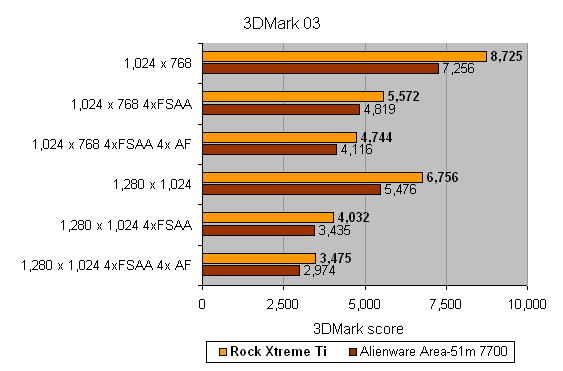
Verdict
Key Specifications
- Review Price: £2209.00
The Alienware name is almost legendary in PC gaming circles. Along with Voodoo, Alienware has tried to make gaming PCs look as good as they perform and has built up a following from users that want to take something special out of their rucksack when they hit the latest LAN party. But this time around Alienware had its work cut out, because making this particular chassis look cool, is far from easy.
The Area-51m 7700 is built into the same Clevo chassis that I’ve seen previously in the shape of the MV Ixius and the Rock Xtreme Ti. Now, to be fair to Alienware, it’s understandable why this chassis is being used, since it’s the only one currently available that can handle the latest, high-end graphics chipsets, but I for one am looking forward to some new designs for high-power gaming notebooks.
Of course Alienware has done its best to make the Area-51m 7700 stand out from its similarly specced competitors, with the lid sporting the usual alien head, rubber ribbing and embossed logo. In fact, it has to be said that when you’re looking at the machine from the rear, the glowing blue alien eyes do look cool, in the same way that the glowing apple does on iBooks and PowerBooks.
So, the Area-51m 7700 doesn’t represent the freshest design in notebook technology, but sometimes beauty can be more than skin deep. Peeling back the epidermis of the 7700, you’ll find the kind of spec that a modern desktop gaming PC wouldn’t be ashamed of. Central processing duties are handled by a 3.6GHz Intel Pentium 4, while 1GB of 533MHz DDRII memory is also thrown in for good measure – so far pretty much the same spec as the Rock Xtreme Ti. There’s also a pair of matched 60GB 7,200rpm hard disks striped in a RAID 0 array for maximum performance.
Where the specifications of the Alienware and the Rock machines do get very different is in the graphics card department. Whereas the Rock Xtreme Ti was the first production notebook that I’d seen using the ATI Mobility Radeon X800 chipset, the Alienware Area-51m 7700 employs the nVidia GeForce GO 6800 chipset. There’s 256MB of memory to keep the GO 6800 flying along, just like with the Mobility Radeon X800. However, it does appear that the ATI solution produces slightly faster results.
I only ran 3D benchmarks on the Area-51m 7700, because that’s really what the target market is interested in. Looking at Half-Life 2 first, it’s clear to see that the Rock is well ahead, but that’s no surprise, given that ATI hardware always performs better in this game. The gap closes considerably when it comes to Doom3, but the Rock still manages edge ahead in all but one of the tests. OpenGL performance is an area where nVidia has traditionally outperformed ATI, so this is an idication that the Mobility Radeon X800 is definitely the faster mobile chipset. This is compounded by the Far Cry scores which show the Rock soaring ahead, with a score almost double that of the Alienware.The numbers produced by 3DMark03 and 05 don’t change too much either, with the Rock managing to beat the Alienware convincingly accross the board.
However, there’s one very good reason why you shouldn’t read a great deal into these benchmark scores, and that’s the fact that Alienware offers a choice of graphics solutions for the Area-51m 7700. So, if you would rather have your machine built with an ATI Mobility Radeon X800 card instead of an nVidia GO 6800, you can, and it won’t cost you a single penny extra. Therefore, it’s reasonable to assume that if this Alienware system had been configured with an ATI solution, the scores would have been pretty close to the Rock Xtreme Ti, since the rest of the specification is more or less identical.
That said, looking at the clock speeds of the Go 6800 card – 250MHz core and 300MHz for the memory (600MHz effective) – I suspect that this is an older DDR1 card, rather than the newer DDR3 version that Alienware is now offering. The core is running even slower than the GO 6800 that was in the MV Ixius that I looked at several months ago, so you could probably push it up to around 275MHz using PowerStrip or something similar. With the faster DDR3 memory version of the GO 6800 you might see a decent performance boost. The good news is that the price I’ve quoted in this review includes the new DDR3 version of the chipset.
As things stand though, the Area-51m is still a great mobile gaming platform. For a bit of subjective testing, I fired up Counter Strike: Source and tried nailing a few bad guys (anyone on the opposite team is a bad guy in my opinion). Running at a widescreen resolution of 1,440 x 900, without any image quality settings, the Area-51m 7700 provided smooth and silky playback – this is definitely a mobile gaming platform that will do you proud at your next LAN party (if you’re into that kind of thing).
But one area where the Alienware does lose out to the Rock is in the display department. Both notebooks sport 17in widescreen panels, but the Rock panel had a resolution of 1,680 x 1,050, while this Area-51m only manages 1,440 x 900. Once again though, Alienware does offer a 1,680 x 1,050 panel as an option, so if you want the extra desktop real estate you can have it, as long as you’re willing to pay the extra £228. That said, the screen on the Area-51m is a standard TFT display, while the Rock Xtreme Ti had a high contrast glossy screen. I know that some people don’t like this finish on TFT screens, but I’m a big fan, especially on a device that’s sole purpose is entertainment.
The keyboard is identical to the the other notebooks I’ve looked at based on the Clevo chassis. It’s a full size affair, with a numeric keypad to the right. Now, if you’ve read my previous reviews you’ll know that I think that the numeric keypad is a mistake. The reason for this is that the numeric keypad pushes the centre of the keyboard over to the left, resulting in you not sitting quite in the middle of the screen. It’s only a small point, but one that annoys me. But, as always I have to put this criticism in context, and it’s not as though it ever bothered me when I was playing games.
Typing on the keyboard is pleasant enough. The keys are full size and there’s a decent amount of travel to the keys. The break is solid and the springback firm, so you can type at a decent speed. There is a little bit of flex when typing hard and fast, but no more than I’ve encountered with many other notebooks. My biggest gripe with the keyboard has to be the tiny left hand Shift key, coupled with the massive right hand one – very strange and not condusive to a fast typer.
The large touchpad is far enough away from the Spacebar to avoid any inadvertant cursor selection when you’re typing fast. As touchpads go it’s decent enough, and has a scrolling section located on the right hand side. I prefer trackpoints, but I imagine that a machine like this will have a mouse plugged into it most of the time.
On the right side of the chassis is an 8x DVD writer that will burn to DVD+R/RW and DVD-R/RW as well as writing to CD-R and CD-RW media. There’s also another bay below this one allowing you to install a second optical drive if you choose to do so.
At the front of the casing is a set of multimedia controls along with an LED display. With these controls you can playback CDs without needing to boot up Windows, and the integrated speakers are good enough to make this a decent option for someone wanting to listen to music.
The left hand side is inundated with features. There’s a single Type II PC Card slot, a 7-in-1 memory card reader. There’s a full complement of audio ports including a stereo line-in, which you don’t see too often. Next to the audio ports, you’ll find two four-pin FireWire ports, four USB 2.0 ports and an S-Video connector.
The rear is equally well stacked with S-Video and composite video inputs, modem socket, a network port for the Gigabit Ethernet controller, a PS/2 port, DVI, parallel and serial ports, and finally the power socket.
There’s also integrated 802.11b/g wireless networking as well as Bluetooth, so you should be able to use the Area-51m to stay in touch under any circumstances.
On the whole the Alienware Area-51m 7700 is a decent mobile gaming platform that would have performed far better if it had been equipped with the latest hardware that the company is now offering. Price wise, it doesn’t come cheap, but then Alienware products rarely do. Alienware quoted me a price of £2209.28 including delivery and VAT, but when I specced the system up on the Alienware website a mail-in rebate of £170 was applied, which brought the cost down considerably.
If you do fancy an Alienware machine, it’s also worth checking out the finance packages on offer. Just remember that you’ll be paying interest, so the overall cost will be higher, but then not too many gamers have over £2,000 burning a hole in their pocket.
It’s hard to give a firm judgment on this machine, because it’s not 100 per cent indicative of what the end user will buy, especially with the newer graphics card giving a major performance boost. That said, the Rock Xtreme Ti, offers a noticable performance edge with a higher resolution, high-contrast screen thrown into the bargain.
”’Verdict”’
Like all the gaming notebooks based on this Clevo chassis, the Alienware Area-51m 7700 does its job admirably. Performance has been spoiled slightly by the older nVidia graphics card employed in the review sample, but customers will benefit from the newer DDR3 version. Ultimately though, you can buy an almost identically specced machine from Rock, with a higher resolution screen for less. With the basic chassis it had to work with, even Alienware hasn’t been able to transform this large, ungainly notebook into something sleek, sexy and desirable. That said, I imagine that Alienware already has a super-cool replacement waiting in the wings and I can’t wait to see it.

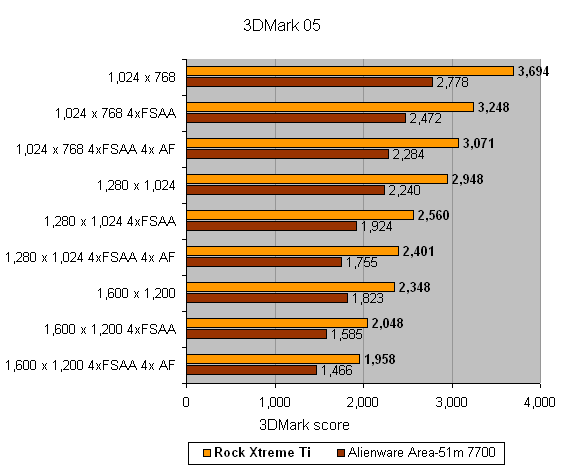
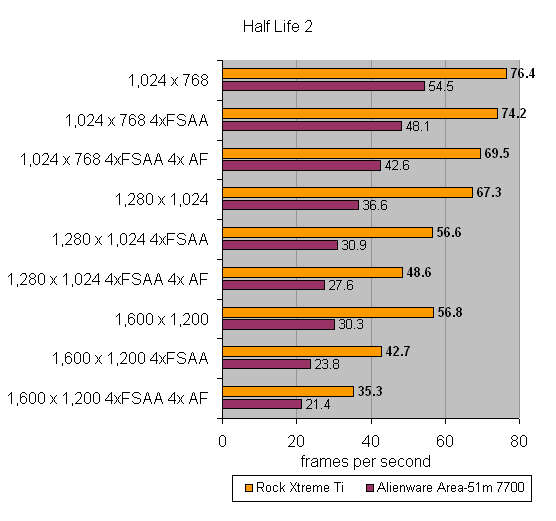
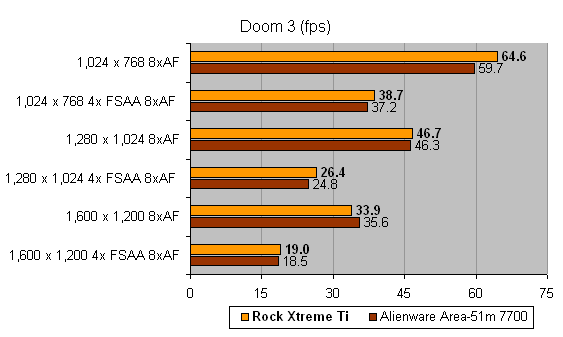
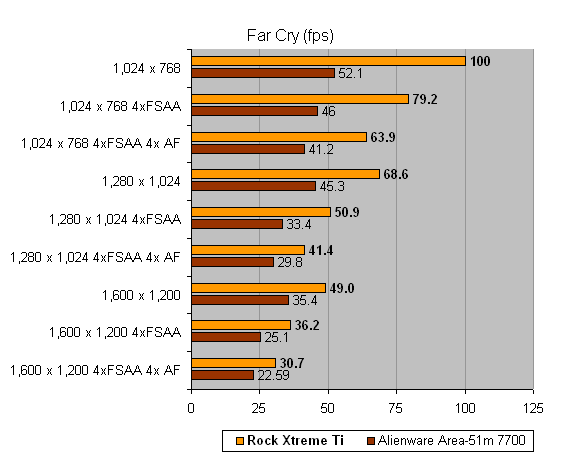
How we test laptops
Unlike other sites, we test every laptop we review thoroughly over an extended period of time. We use industry standard tests to compare features properly. We’ll always tell you what we find. We never, ever, accept money to review a product.
Trusted Score
Score in detail
-
Performance 9
-
Value 7
-
Features 8

